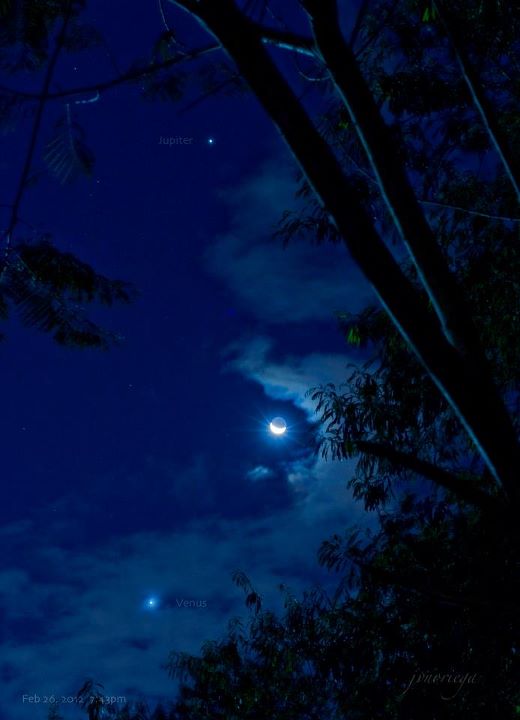All five visible planets in the March 2012 evening sky: Mercury (early March), Venus, Jupiter, Mars, Saturn (mid to late evening)

Venus, below, moon and Jupiter, above, as seen February 26, 2012 in Manila, Philippines by Jv Noriega. Jupiter and Venus will be closest in mid-March. The moon will sweep near them again in late March 2012.
Wow, March 2012 is about as good as it gets for planet watching!
Mercury, the innermost planet, makes its best evening appearance for the year in the Northern Hemisphere. All over the world,
Mars shines at its greatest brilliance for the year – and moreover, the red planet stays out all night long. Plus, the brightest and second-brightest planets –
Venus and
Jupiter, respectively – come together for a stunning conjunction in mid-March.
Saturn, the farthest and faintest visible planet, is nonetheless as bright as the brightest stars, and its glorious rings are surprisingly easy to view through a backyard telescope.
Illustrated guide to Venus Jupiter conjunction in March 2012
Great photos of spectacular Venus Jupiter conjunction on EarthSky’s Facebook page
Mars in March 2012
Four of the five visible planets –
Mercury,
Venus,
Jupiter and
Mars – pop out first thing at dusk.
Saturn comes up later in the evening. All of these worlds should be easy to see, with the sole exception of
Mercury, the innermost planet of the solar system. As darkness falls, Venus and Jupiter blaze away in the western sky, while fainter Mercury lurks beneath them, near the horizon. The red planet
Mars is found low in the east at dusk and nightfall, beaming as the sky’s fourth-brightest “star,” after
Sirius. Sirius, the brightest star in the nighttime sky, is only a touch brighter than Mars, and sparkles in the Northern Hemisphere’s southern sky at early evening.

Use the dazzling planets Jupiter and Venus to locate Mercury near the horizon
Make Mercury a priority in early March, for the first week of March will feature the Northern Hemisphere’s best opportunity to catch Mercury in the evening sky until June 2012. First thing, after sunset, look for the dazzling planets Venus and Jupiter to burst into western twilight dusk. Then draw an imaginary line from Jupiter and past Venus to locate Mercury near the sunset point on the horizon.
Mercury at its best, shining below Jupiter and Venus
Given an unobstructed horizon and clear sky,
Mercury may become visible to the unaided eye about 45 to 60 minutes after
sunset. Binoculars, though, make the search for Mercury so much easier, especially if the sky is murky near the horizon – as is so often the case. Mercury is actually as bright as a first-magnitude star, but the glow of evening twilight tends to subdue its brilliance. With Mercury setting a whopping 90 minutes after the sun at mid-northern latitudes, Mercury may well be yours to behold just before darkness falls in the first week of March.

The moon, Jupiter and Venus as seen from North America on Saturday, March 24
Venus blazes like a lighthouse in the west at dusk in March 2012, as seen from all parts of Earth. In fact, all through March 2012,
Venus and
Jupiter – the sky’s two most brilliant planets – are the first “stars” to pop out at evening dusk, with Venus being the lower planet and Jupiter the higher in the first half of the month. After Venus and Jupiter have their conjunction at mid-month, Venus will become the higher planet and Jupiter the lower.
Best Jupiter-Venus conjunction in years in mid-March 2012
At mid-northern latitudes, Venus follows the sun beneath the western horizon about four hours after sunset all through March. Day by day, you’ll be able to watch Venus climb a little closer to Jupiter into the evening sky. It’ll finally meet up with Jupiter around mid-March 2012, when
Jupiter and Venus will stage an amazing conjunction in the western twilight sky.
Watch the waxing crescent moon swing close to Jupiter and Venus in late March, on the evenings of March
24 and
25 and
26.
At the beginning of the month, Jupiter sets about five hours after the sun and Venus sets about four hours after at mid-northern latitudes. Every evening thereafter, watch for Venus to climb upward while Jupiter falls downward. By the end of the month, Jupiter will set about two and one-half hours after the sun yet Venus will still set a good four hours after
sunset.

Jupiter and its moons as seen on August 15, 2009. From left to right, these moons are Europa, Ganymede, Io and Callisto.
Even on a moonlit night, it’s pretty easy to see Jupiter’s four largest moons with a backyard telescope. In their outward order from Jupiter, these moons are Io, Europa, Ganymede and Callisto. However, the positions of Jupiter’s moons – as seen from Earth – vary from night to night. Sometimes, a moon may be “missing” because it’s in front of or behind Jupiter. If you want to know which moon is which at a certain date and time, check out this handy
almanac.
Jupiter photo credit:
Velo Steve
Mars is rising in the east as the sun sets in the west in early March 2012. This is the other planet that will “wow” you on these March evenings. Mars reaches opposition on March 3, at which juncture this brilliant, ruddy world shines all night long, from dusk till dawn. Mars will become extremely noticeable in our sky in March – more noticeable than it’s been for the last two years. Very exciting!
Mars at opposition on March 3, 2012
Mars comes closest to Earth on March 5, 2012
Excitement is reaching to a fever pitch as
Mars is now displaying its greatest brilliance in our sky. Mars started to retrograde (move westward) toward the star Regulus in the constellation Leo on
January 24. Mars has been brightening ever since retrograde motion began, and its brilliance culminates with the Martian opposition in early March. Mars is now the fourth-brightest “star” in the nighttime sky, after the planets Venus and Jupiter, and the star Sirius, the brightest true star of the nighttime sky.
In early March 2012 – just as Venus and Jupiter are gearing up for their spectacular conjunction – Earth passes in between the sun and Mars. Mars comes closest to Earth for this two-year period and shines most brightly in our sky. This is the wonderful Martian
opposition. Although this 2012 opposition will be a rather distant one for Mars, any Martian opposition is a grand event. It’s when we remember why we love this planet! So be sure to watch for Mars.

Look for the star Regulus and the planet Mars by the moon as darkness falls on Monday, April 2
If you missed seeing the moon with Mars on the nights of March
6 and
7, try again on
April 2. Mars shines in front of the constellation Leo the Lion, but easily outshines the Lion’s brightest star, Regulus. You can also distinguish Mars from Regulus by color. Mars glowers in a ruddy hue while Regulus sparkles blue-white.
Moon swings close to a Royal Star and Mars on April 2
Waxing moon with planet Mars and star Regulus on April 3
At mid-northern latitudes, Saturn rises in the east around 9 to 10 p.m. local time in early March 2012 – or at about the same time that Venus sets in the west. By the end of the month, Saturn is rising at nightfall – or approximately 8:30 to 9:30 p.m. local daylight saving time. Starting around mid-month, you can see Venus sitting low in the west as Saturn is rising in the east. Saturn appears highest in the sky around 3 a.m. local time in early March and about 2 a.m. local daylight saving time by the month’s end.
Give me 5 minutes, and I’ll give you Saturn in 2012

Full moon by the star Spica and planet Saturn on Friday, April 6
Saturn isn’t as dazzling as Venus or Jupiter. It’s not as exciting as Mars or Mercury. It’s the least conspicuous of the visible planets. In fact, early stargazers used to call Saturn “the oldest of the old sheep.” Thank goodness Saturn is fairly close to Virgo’s brightest star,
Spica now. If you see two bright objects close together on the sky’s dome, one of them might be Saturn!
If you missed the beautiful pairing of the waning gibbous moon with Saturn and Spica on the night of
March 10, watch as the first full moon of spring joins up with Saturn and Spica on
April 6.
April full moon near Spica and Saturn on April 6
Morning planets in February 2012: Mars and Saturn
Although Mars appears in the evening sky and Saturn at mid-evening, these two worlds light up the morning hours after midnight all the way till dawn throughout March 2012.
Bottom line: Excitement is building with respect to planets in Earth’s sky. Jupiter and Venus are edging toward a spectacular conjunction in March 2012. Mars is at its brightest and shines opposite of Jupiter and Venus as soon as darkness falls! This month, three planets – Venus, Jupiter and Mars – conspicuously stage themselves in the March 2012 evening sky, while Saturn more modestly displays itself from mid-evening until dawn. Mercury, the shyest of the five visible planets, will put on a good showing after sunset during the first week of March.




















































